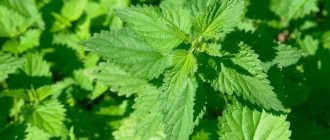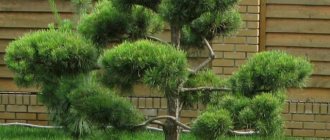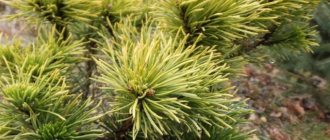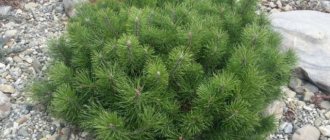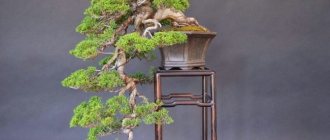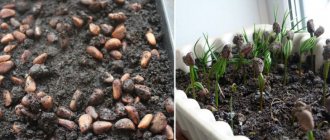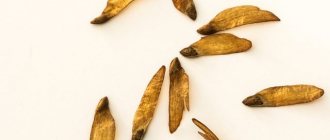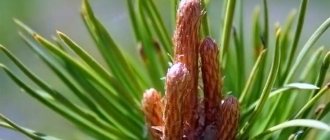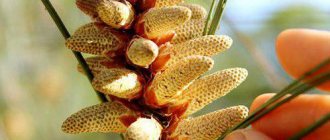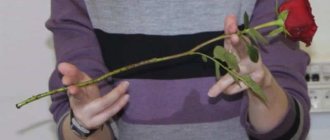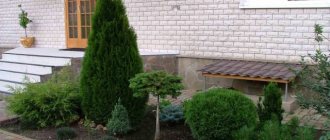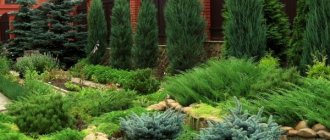Botanical description
Scots pine (in other words, forest pine) is a type of coniferous tree with a specific and refreshing aroma. The root system is plastic, formed depending on the structure and composition of the soil. The maximum height of pine is 35-40 m, there are specimens up to 50 m.
The trunk is straight, branched, reaches 0.6-1.2 m in diameter. The crown is cone-shaped, round, thick. The bark is brownish with deep cracks at the base, and at the top it is thin and scaly with a light brown hue. The branches are densely covered with long green needles. Scots pine needles are pointed, dense, arranged in pairs, reaching 4-7 cm in length.
Below is the classification of pine
| Kingdom | Plants |
| Department/Class | Conifers |
| Family | Pine |
| Genus | Pine |
| View | P. Sylvéstris (S. Ordinary) |
The fruits of the tree are elongated cone-shaped cones. They reach 2-7 cm in length and 2-4 cm in width. They are located singly or in 2-3 pieces on a branch. In the second year they become woody and change from light green to brown. The seed ripens in the fruit and remains viable for 7 years. Seeds of different colors, elongated, reach 3 mm in length. They have an easily detachable wing that wraps around the sides of the seed. The period of departure from the cone is March–June.
Sketch a pine shoot??? Laboratory work . Getting to know the external structure of a plant
Detailed solution for laboratory work 3 in biology for 5th grade students, authors Ponomareva I.N., Nikolaev I.V., Kornilova O.A. 2015
- Gdz Biology workbook for grade 5 can be found
← →
Exercise 1.
1. Look carefully at a branch of a flowering plant.
Answer.
2. Find the parts of the shoot - stem, leaves, buds.
Answer.
3. Using a hand magnifying glass, examine how the buds are located on the shoot.
Answer.
4. Draw an escape in a notebook in the form of a diagram, mark the main parts of the escape.
Answer.
5. Draw a conclusion.
Answer. A shoot is a stem with leaves and buds located on it.
Task 2. Examination of the structure of a pine shoot.
1. Find shoots on a pine branch. Count them.
Answer. There are two types of pine shoots: long and short. The leaves on long shoots are brown and scaly. Leaves on short shoots are 5-9 cm long, needle-shaped, arranged in bunches of 2-5 pieces. According to the number of leaves in a bunch, pine species are called two-cone, three-cone and five-cone.
2. Find shortened shoots that bear needles. Find out how many needles are on one shortened shoot.
Answer. Most pine species have 2.
3. Draw a shortened pine shoot with needles in your notebook.
Answer.
4. Find out where the pine cone is located.
Answer.
In spring, small reddish cones can be seen on the tops of young shoots. These are female bumps. On the same branches on which the female ones are located, there are also male cones. They are located not at the top of the young shoot, but at their base. Male cones are small, oval, yellow and collected in close groups.
5. Make a general conclusion about the diversity of shoots in plants.
Answer. Plant shoots differ in structure, shape, origin, and size. The variety of shoots helps plants better adapt to different living conditions. Different shoots perform different functions.
Habitat
Asia and Europe are the habitat of pine. The plant can be found in Great Britain, Spain, CIS countries, Mongolia, and China. On poor and dry lands it forms pine forests, and on fertile lands it is part of mixed forests.
The tree does not impose requirements on humidity and soil composition. Most often it grows on sandy loam, peat, turf, and podzolic soils. Occupies areas unfavorable for other crops - swamps, sands. Forms pure and mixed forests. Its neighbors may be birch, spruce, oak.
Scots pine most often grows on sandy loam, peat, turf, and podzolic soils.
Distribution of Scots pine: greatest concentration in Siberia, the Caucasus, in the areas of the Lena River, Angara, Irtysh, Ob, Oka. The distribution area in Siberia occupies more than 5 million sq. km.
Heights that pine trees reach
The height of the pine depends on the growing conditions. If the tree grew on good soil and in a climate zone with moderate moisture and long summers, then it can reach a height of 30-40 m. At this height, the trunk diameter at 1.5 m ranges from 50 to 120 cm. In order to the tree has reached such indicators, it not only must grow in favorable conditions. At an early age, it should not be exposed to fires and other damaging factors.
There are record holders among the pines. Specimens have been recorded that have reached a height of 45 m, a diameter of 150 cm, and an age of 300 years.
If damaged at an early age, the tree will not be able to develop a tall trunk and a good crown. This is how specimens appear that, in good soil, grow small, twisted, and with a deformed crown.
A pine tree growing in unfavorable conditions (swamp, rocks, long frosty winter) will never grow large. The average size of such specimens ranges from 1 to 10 m. Their diameter ranges from 15 to 30 cm. However, they can live a long time. Cases of discovery of hundred-year-old pine trees have been recorded.
Peculiarities
Pine is a light-loving plant that adapts to the temperature conditions of its growing environment. The root system, depending on the habitat, adapts to the conditions. In arid areas, the tap root is more developed; in areas with a moderately humid climate, lateral roots develop.
The pine tree reproduces by seed and grafting. Transplantation of seedlings begins at 3-7 years of age. Flowering begins in mid-May - the temperature at this time is already high. During this period, a cloud of “yellow dust” rises above the forest. Pollination occurs with the help of wind, fertilization is expected next year. It begins to bear fruit at the age of 15 when planted alone, in the forest - after 40 years. The average lifespan of a tree is 200-300 years, in some cases it lives up to 500 years. It grows moderately, maximum growth is expected at 15-20 years of age
So, the features of Scots pine are: it has good survival rate, adapts to different temperature conditions, is drought-resistant and light-loving. The root system prevents soil erosion, the collapse of old ravines and the formation of new cliffs.
Shoot of a flowering plant. Plant shoot: structure and functions
The organs of flowering plants, the most evolutionarily developed representatives of this kingdom of living nature, have a fairly diverse structure and functions. The underground part of the plant is called the root, the above-ground part is the shoot. It is the plant shoot that carries out the most important functions: gas exchange, photosynthesis, transpiration, vegetative propagation and its optimal location in relation to the sun.
Origin of the escape
In the process of evolution, this organ appears in the first land-dwellers—rhiniophytes. Its stems were creeping and forked because the mechanical tissues were still poorly developed. But even with such a primitive structure, the photosynthetic surface increased, which means that the plant organism was better provided with carbohydrates.
What is a shoot in plants?
A shoot is the above-ground part of a plant, consisting of a stem and leaves. All these organs are vegetative, providing growth, nutrition and asexual reproduction.
Plant shoots also contain rudimentary organs - buds. There are two types of buds: vegetative and generative. The first type consists of a rudimentary stem and leaf, on top of which there is educational tissue (meristem), represented by a growth cone. If, in addition to the stem and leaves, the bud contains the rudiments of flowers or inflorescences, it is called generative. In appearance, such buds are distinguished by their larger size and rounded shape.
The place to which a leaf is attached on the stem is called a node, and the distance between the nodes is called an internode. The angle between the stem and the leaf is called the axil.
During the development process, organs responsible for generative (sexual) reproduction also appear on the shoot: flower, fruit and seed.
Development of a shoot from a bud
With the onset of favorable conditions in spring, the cells of the growth cone meristem begin to actively divide. Shortened internodes increase in size, resulting in the appearance of young plant shoots. At the very top of the stem there are apical buds. They ensure the plant grows in length. Axillary and adventitious buds are located in the leaf axil or on the internode, respectively. Due to them, the stem forms lateral shoots, i.e., branches.
Plant branching methods
Depending on the structure, there are several ways to branch shoots:
- Dichotomous. The most primitive type of branching, in which two growth points develop from one point, two from each of them, etc. This is how some algae and higher spore plants grow: mosses and ferns.
- Primopodial. Such branching can be seen both in gymnosperms (pine, spruce) and angiosperms (oak, maple). For a long time, the stem of these plants grew in length, followed by the formation of lateral branching.
- Sympodial. With this method, apical growth, on the contrary, stops. And the side buds are actively growing, forming more and more side shoots. Pear, cherry and other flowering plants are typical examples of this type of growth.
Modifications of shoots
Everyone certainly knows what a plant shoot is and what it looks like. But environmental conditions often require additional functions. This is easily provided by the organs of flowering plants. The shoot changes, acquiring new structural features, while consisting of parts of a standard shoot.
The main modifications of the escape include:
- Rhizome - located underground, where it most often grows horizontally. It has elongated internodes and buds, from which leaves appear on the surface of the earth during a favorable period. Therefore, plants with rhizomes (lily of the valley, wheatgrass, valerian) are very difficult to get rid of. After tearing off the leaves, the shoot itself remains in the ground, growing more and more.
- A tuber is a thickened internode with buds called eyes. The most striking representative of plants that form tubers is potatoes. Because it grows in the ground, it is often confused with a modified root. However, there are also above-ground tubers, for example, kohlrabi.
- A bulb is a modified shoot of plants with well-developed leaves located on a flat stem - the bottom. Typical for garlic, onion, tulip, lily. Nutrients accumulate in the succulent inner leaves, and the dry outer leaves protect them from damage.
- Thorns are a protective device of pear, sea buckthorn, hawthorn and other plants. Being in the leaf axil, they reliably protect the plant from animals that want to feast on it.
- Tendrils are modified climbing shoots that fix plants in a certain position. Cucumber, grapes, and pumpkin are the most common plants that use this device.
- Whiskers are thin shoots with long internodes. Strawberries and wild strawberries reproduce vegetatively with the help of whiskers.
As you can see, a plant shoot consists of parts that are functionally interconnected, can change depending on environmental conditions and give each plant its own unique appearance.
Types and varieties
Forest pine occupies about 60% of all coniferous plants. In different parts of the habitat, scientists have identified varieties and ecotypes that are characteristic of specific areas of growth. Currently, three subspecies of P. Sylvéstris (S. vulgare) are considered:
- Hamata Steven . Habitat Balkan Peninsula, Transcaucasia.
- Lapponica. Habitat: Finland, Sweden, Russia, Solovetsky Islands.
- Mongolica Lity . Habitat Mongolia China, Transbaikalia, Siberia.
Characteristics of pine depending on the variety:
- Vattereri.
A popular variety of P. Sylvéstris, often used in landscaping. It has a rounded crown, a green crown with a bluish tint. It grows slowly - the growth per year is about 10 cm, only at the age of 30 it grows to 3 meters, over the years the height reaches 7 m.
- Globoza Viridiz.
Another dwarf variety. It reaches a height of up to 1.5 meters. It has a pyramidal or spherical dense crown of dark green color. A distinctive feature is the presence of short (current year needles) and long (last year) needles. Does not like waterlogging and city dust.
- Fastigiata.
A fast-growing variety with a straight trunk and a narrow-columnar crown. The needles are grayish-green, hard. Growth per year is about 20 cm in height and 5 cm in width. An adult tree reaches 10-14 meters. In common parlance, the variety was called “Blue Candle”.
- Jeremiah.
A miniature representative of Scots pine. A very original variety with a green-bluish crown. In landscape design it is used for rock gardens and rocky gardens.
- Kelpie.
A low-growing, rare variety intended for decorating summer cottages and private areas. The needles are hard and thick, rich green in color. It reaches a height of up to 0.8 m, and a diameter of 1.2 m. The annual growth rate is about 7 cm.
- Sport of Repens.
A rare and unusual variety, which is often classified as a shrub. The needles are hard, densely spaced, and grayish-greenish in color. It reaches a height of up to 0.5 m, a diameter of 0.8 m. Growth per year is about 5 cm.
Dwarf varieties look great when planted alone or in a group composition. Suitable for rock gardens and rocky gardens. Low-growing varieties look advantageous in contrast with taller plants, tall ones - in large spaces.
Pine subspecies have several forms or ecotypes
Collar pine. Studying the diversity of forms of Scots pine, Professor B.V. Grozdov discovered the original ringed form of pine in the Bryansk region and called it collared. The tree grew in an old pine plantation, its trunk was with rough cracks and had, on the illuminated side, in places overgrown with whorled branches, what looked like visors made of exfoliated bark plates; the canopies rose along the trunk to a height of up to 6 meters.
Walter Seitz reported about the same pine in one of the German forestries in 1927; he classified it as a scaly form. The pine was 200 years old, with twelve canopies made of narrow scales of bark and also in place of overgrown whorls from the illuminated part of the trunk. In 1955, similar pines were found in the forests of Poland.
Observations have shown that changes in the bark at the site of overgrown whorls are characteristic of older trees. The bark first completely covers the unevenness of the whorls, and then cracks, and its layers, rising, take on an inclined shape, which is facilitated by the abundance of sunlight and dry air. Collar pine is found in such places. On the shady side of the trunk, all the pines we encountered did not have canopies; The bark of such pines peeled off in “tablets.”
The trees are most often found in pine-oak plantations, oak-beech with hornbeam, and beech with an admixture of Scots pine and hornbeam. There are pines aged 115-125 years.
Seven years of observations over an area of about 10 hectares were unexpected. It turns out that the number of trunks with collars and the number of collars on each counted trunk changed annually: in the first year there were 56 pines with collars, after 3 years - 92, after another 2 years - 120, and in the last year - 156. It is also interesting that in the first year of observation, trees with four collars predominated (maximum - ten), and in the last year - with seven (maximum - 16-19 collars). This means that new collars must appear on ripe and overmature pines. Another original feature has been noticed in collared pines (especially in the Lviv region): you can find trees not only with half rings, but also with full rings, and the number of the latter increases with the increase in the total number of collars on the trunks.
Collar pines have deeply cracked bark and only a few thin trunks. The well-developed crown and slenderness of the trees attract attention: the thinness of the trunks and the cleanliness of the trunks from branches. Pines bear fruit abundantly and produce seeds of great germination. All this speaks of the high forestry properties of this rare, remarkable tree and the need for a more in-depth study of it and its use in forest park construction.
Chalk pine . There are rocky chalk slopes on the Central Russian Upland and the Donetsk Ridge. They would seem to be completely unsuitable for tree life. And yet, the plants managed to settle here and even survive to this day. These are chalk pines.
A tall tree, up to 30 m in height, has a wide crown, quite often descending down the trunk; with age it turns into an umbrella-shaped one. The vitality of chalk pine is facilitated by the root system: the anchor roots pass through heavy soil without branches, and at the ends they form a mass of thin, hair-thin roots, entwining chalk blocks like felt. It is interesting that at a depth of up to 1.5 meters these blocks are wet from the surface; on the felt itself, tiny droplets of water are visible.
The needles of chalk pine are somewhat shorter, wider and thicker than those of Scots pine. The cones are up to 3 cm long; scientists explain their reduced size by poor soils.
Cretaceous pine is not distinguished as a special species, since there are no differences in the anatomical structure of wood and needles; scientists see in it only a variety of Scots pine. According to most, chalk pine is a relic. Its peculiarity of growing essentially on bare chalk has historically developed a long time ago and is hereditary. For normal growth and development of trees, a high concentration of alkaline substances is required. The characteristics of chalk pine have, of course, not only scientific, but also practical value, since it is possible to use these trees wherever there are chalk slopes.
Studies of plantings in the Belgorod region on bare chalk showed that only chalk pine and Crimean pine can grow there, while other species die or acquire dwarf forms.
Foresters overcome some difficulties when creating stands of chalk pine: it is difficult, for example, to collect seeds on steep slopes, and at the same time, small islands of surviving natural plantings cannot yet meet the needs for seed material. Now measures have been taken to strengthen the protection of pockets of rare pine - the most valuable reserve of the seed fund - and to create a reserve regime in the places where it grows.
Grave pine , or funerary pine . She often landed in cemeteries in Korea. In our Far East, it is currently distributed in small areas or groups, significantly distant from each other, in the southwestern part of the Primorsky Territory, as well as in the Girin and Mukden provinces of Northeast China. In the past, even houses were built from its wood.
The tree differs sharply from other related species in its appearance and ability to grow in dry places and in full sun. Wide umbrella-shaped dark green crowns and yellowish-orange trunks of pine trees stand out against the background of deciduous trees. Pine settles on granite outcrops and rocks, on steep southern slopes and ridge ridges exposed to winds, on humus-depleted soils containing large amounts of crushed stone, as well as on sandy coastal deposits.
According to scientists, gravel pine is a fast-growing valuable species of great interest for forestry, for strengthening soils, protecting them and protecting water.
In one of the Far Eastern pine groves, 100 years old, under extremely unfavorable conditions (excessive dryness, rocky soil, frequent fires), the pine reached a height of 12 m and had a diameter at chest height of more than 40 cm. In somewhat more favorable conditions, trees are found much larger and reach the age of ripeness by 90 years.
Academician V.L. Komarov said about the characteristics of the grave pine and its plantings: “This is a completely unique type of vegetation, clearly different from all the others... not a forest tree, but one grown in the light.”
Based on a combination of characteristics (limited range, stable ecological features, and others), the grave pine is an older species compared to the Scots pine. The latter, as a younger, progressive species, quickly spread and became one of the pine forest-forming species throughout much of Eurasia. Grave pine has reduced its range to a minimum due to changes in climatic conditions (primarily due to humidity), and later - under the influence of human activity. Therefore, pine forests in the Primorsky Territory are recognized as relict.
Pyramid pine . Several years ago, interesting information appeared: in Northern Kazakhstan, scientists discovered a peculiar pine tree. It had a narrow-conical pyramidal crown, and thin branches along its entire length extended from the trunk at a strictly acute angle. The pine naturally differed in appearance from its relatives growing nearby - from the Scots pine. The tree had quite good growth: at the age of 60 it gained a height of 22.5 m and a diameter of 30 cm at chest height.
Further research and observations showed that the pyramidal trait was preserved in the offspring: seedlings (two-year-olds) grown from pine seeds and planted in the ground also had a pyramidal crown by the age of 5-6 years. Observations are still ongoing.
To content >>>
Medicinal properties
Scots pine is often used for medicinal purposes. Decoctions, infusions, syrups, and ointments are prepared from raw materials. They have anti-inflammatory, diuretic, antibacterial, expectorant, hemostatic, and disinfectant effects. Pine essential oils are used in cosmetology. The products remove dandruff, strengthen and add shine to hair, and stimulate skin cell regeneration processes.
The beneficial properties of Scots pine are determined by the substances that make up the raw material. It contains high concentrations of essential oils, acids, vitamins, carotene and other useful components. Folk elixirs are taken in the following cases:
- for the prevention of vitamin deficiency;
- for joint diseases;
- for cardiovascular pathologies;
- for liver and kidney diseases;
- for ulcers and gastritis;
- for bronchitis, pneumonia;
- for colds;
- for cystitis.
Spreading
A Handbook of the World's Conifers (2010) recognizes 113 species of pine trees. Pines are almost exclusively restricted to the northern hemisphere, crossing the equator only on the island of Sumatra in Indonesia (P. merkusii). Unlike other genera of the pine family, the greatest diversity of species is concentrated in the United States and Mexico - more than in China and Japan. Some species of pine trees are widespread and form forests in the northern hemisphere. The largest range has the Scots pine (P. sylvestris), widespread across the vast expanses of Eurasia. In the Rocky Mountains of North America, lodgepole pine (P. contorta) is the most common conifer. However, most pine trees have a very limited range.
Interesting Facts
The most interesting information about Scots pine:
- Even in ancient times, the tree was revered by healers and used as a medicinal plant. In Rus', resin was used to treat diseases of the teeth and oral cavity.
- In Ancient Egypt, resin was added to special compositions for embalming corpses.
- The tallest Scots pine can be found on the Baltic Sea coast.
- According to popular belief, the resin of old trees attracts wealth.
- Walking in pine forests has a beneficial effect on the respiratory and nervous systems - it calms you down and relieves stress.
- Resin is involved in the production of turpentine and rosin.
- Scots pine is an object of forest exploitation. It is used in shipbuilding, furniture production, and for the construction of dams and piers.
Scots pine is a common evergreen tree. It grows in different climatic conditions, its habitat is the territory of Europe and Asia. The raw materials are used in folk medicine, in the furniture industry, and shipbuilding.
Pests and diseases
Harmful insects, fungal and other diseases, and some species of wild animals play a negative role in the life of pine forests. Young pine trees are inhabited by many insects that damage various parts of plants. On light sandy, loamy soils, insects cause great harm, the larvae of which damage the roots of pine trees. The May oriental beetle is especially harmful. The flight of these beetles begins at the end of April-May and lasts about a month. Females lay eggs in the soil to a depth of 10-40 cm. The larvae that emerge from the eggs first feed on thin roots. As they grow, they develop thicker roots. The larvae grow for 3-4 years. In the summer, the larvae are found in the upper horizons of the soil, and closer to autumn they go deeper to 70-120 cm, where they overwinter.
Young pine trees are often damaged by shoots - summer, winter, bud and tar.
Leaf roller butterflies are commonly called shoot moths, the caterpillars of which damage the buds and shoots of pine trees, resulting in multi-topped trunks, which impairs the growth, quality and productivity of plantings.
The large pine weevil causes significant damage to pine trees. It appears especially often in clear-cuts in lingonberry and blueberry forests.
Young pines growing on dry soils often suffer from pine subbark mites. Numerous needle-eating insects that feed on needles in the larval (caterpillar) phase are also dangerous. As a result of the loss of needles, tree stands completely or partially dry out, at the same time being an object for the reproduction of stem pests in them. The pine silkworm is considered the most dangerous pest of pure pine forests.
No less serious pine-eating pests of pine plantings: pine cutworm, sawflies, Siberian silkworm, nun silkworm, pine moth, star weaver. Protection of pine forests from damage by pine-eating pests is ensured by a set of preventive and exterminatory control measures.
Pine trunks and branches are damaged by a large number of insects, so-called stem pests. These include bark beetles, longhorned beetles, borers, etc. Stem pests, as a rule, settle on trees that are physiologically weakened by unfavorable factors: drought, livestock grazing, damage by pine-eating insects. Reproducing on weakened trees, these pests also spread to viable trees. Most also settle on freshly cut trees and harvested wood.
Wood worn down by stem pests loses its technical properties.
Forest protection measures to combat stem pests are aimed mainly at eliminating the causes that weaken the vital activity of plantations.
Pine forests often suffer from diseases caused by fungi, bacteria, and viruses. In forest nurseries, one- and two-year-old seedlings and young trees are damaged by a fungus, the common schutte. The first external signs of the disease appear on the needles in the form of straw-yellow spots; later the needles become redder and fall off, which leads to the death of the plant. To protect against Schutte diseases, preventive measures should be taken, including agrotechnical and chemical control measures.
Other types of fungi that can cause damage to pine: resin cancer, pine sponge, root sponge. Pine roots are often affected by honey fungus.
From the animal world, moose cause great harm. They not only bite shoots and gnaw the bark, but also break and trample young trees, and are also an indirect cause of the spread of stem pests and fungal diseases.
Pine forests suffer from snow and snow blows.
To content >>>
Planting pine trees in open ground
What time to plant
Three to five year old seedlings with a closed root system are ideal for planting in open soil. If the roots of the seedling are in the open air, then after 10–15 minutes. they will die. It is recommended to buy seedlings exclusively from specialized nurseries located in your region.
Before planting, the root system of the plant is immersed in water, where it should remain for 3 hours, and there is no need to remove it from the container. Pine is planted in open soil from the last days of April to the first days of May or from the end of August to the second half of September.
Landing rules
The depth of the planting pit should be approximately 100 cm. If the soil in the area is heavy, then a twenty-centimeter thick drainage layer of broken brick or expanded clay should be made at the bottom of the pit, then it is sprinkled with sand. The soil mixture for filling the hole should be prepared in advance. To do this, you need to combine the fertile top layer of soil with clay or sand and turf soil in a ratio of 2:1:2. You need to add 100 grams of Kemira-station wagon or 50 grams of Nitrophoska into the finished soil mixture, everything is mixed well. If the soil is acidic, then you still need to add 200 to 300 grams of slaked lime. Part of the earth mixture needs to be poured into the foundation pit, after which a seedling is installed in it, which must be very carefully pulled out of the container, while trying to ensure that the earthen lump remains intact. Then the remaining voids must be filled with soil mixture; this is done gradually, while the soil mixture must be slightly compacted.
When the pine tree is planted, an earthen dump is made around it, after which 20 liters of water are poured into the circle around the trunk. After the liquid is completely absorbed and the soil settles, the root collar of the seedling should be flush with the surface of the site. It should be noted that when planting large trees, the root collar should rise 10 centimeters above the surface of the site. After some time it will drop to the level of the ground surface. When planting several seedlings, a distance of at least 4 meters must be maintained between them, but between trees of low-growing varieties, an interval of only 150 cm will be sufficient.
Planting mountain pine. Mountain pine care
A haircut
Often, pine trees do not need pruning. But with this procedure you can slow down the development of the tree. As a result, the density of the crown will increase. This does not require special materials; it is enough to break off a third of the young growth.
But using simple tricks, you can transform an ordinary pine tree into a bonsai or a small tree. An umbrella-shaped haircut is used for this. In order to maintain the shape and decorativeness of a bonsai, it is necessary to pay attention to the tree and care for it. Shoots are pruned once a year.
https://www.youtube.com/watch?v=ytdevru
So, pine is an interesting tree that has its own characteristics. Each part of it is unique, right down to the root system, which is different from other plants. To grow a pine tree, it is enough to know some rules.
Spruce and pine cones
The cones of these two conifers also have their own differences. There are male and female pine cones. In spring, light yellow inflorescences grow on young branches. These are male bumps, they are very small, like a pea. Female cones are initially just as small, only located one at a time at the end of the branch. At first it is difficult to see them in the thick pine needles. An adult pine cone resembles a spinning top. The seeds ripen in the second year after pollination.
Spruce cones are also male and female. They develop differently. Female cones are initially bright red in color and the size of a hazelnut. They are located at the top of the crown. Male cones have a yellowish tint; pollen ripens in them. Mature cones hang downward and look like cigars. The first seeds ripen in trees 20 years old and older.
Selection
Many cultivars known in horticulture were found in nature. But there are many that originate from nurseries, as a result of selection from mass plantings made by inquisitive and observant nurserymen. Mountain pine (P. mugo) has numerous, very decorative garden forms. For example, the pyramidal cultivar 'Rigi' (Draijer, 1982) is an excellent form in which the juvenile needles are initially greyish-green and later dark green. Creeping forms are widely used as ground cover. Clones such as 'Mops' (Hooftman, 1951) and 'Gnom' (Hort. USA, 1937) are great in containers on balconies (provided they are protected for the winter), or in small gardens. Pinus mugo 'Humpy' (Draijer, 1979) is one of the dwarf forms of mountain pine, with very short needles. And P. mugo 'Ophir' (KJ Kraan, 1975) has attractive yellow needles in the winter months. Austrian black pine (P. nigra) is also widely grown in its homeland and abroad. Several good cultivars come from this species, among them the relatively new 'Geant de Suisse': compact form, distinguished by long needles, bred in the vicinity of Lausanne (Switzerland). Japanese pine with few flowers (P. parviflora) is a wonderful tree of small size.
This species includes several garden forms, all with bluish-gray needles. In Japan, these cultivars are often used to create bonsai. Of those bred in Holland, we can note 'Tempelhof' (Konijn Nurseries, 1965) and 'Gimborn's Ideal' (Den Ouden/Boom, 1965). Weymouth pine (P. strobus) is unsuitable for small gardens. Moreover, it is susceptible to rust. But its cultivar 'Radiata' (Hornibrook, 1923) is considered the best known garden form: it forms a low, wide-growing plant. In the USA, its weeping garden form 'Pendula' (Nelson, 1866) is widely cultivated. Scots pine is also considered an important plant in ornamental gardening; its semi-dwarf cultivar 'Watereri' (Beissner, 1891) is appreciated in Western Europe. A relatively new cultivar is 'Bonna' (Hort. NL, 1990) - with a pronounced bluish color of the needles.
Pine propagation
Pine trees can be propagated by grafting, cuttings and seeds. As a rule, vegetative methods of pine propagation are reliable and provide faster results. But most often such a tree is propagated by seeds.
Growing pine from seeds
Well-ripened fresh seeds are used for sowing. The collection of cones should be carried out in the last days of October or in the first days of November, during this period the seeds in them will already be fully ripe and suitable for sowing. It should be noted that the cones must be picked from the pine tree, and not collected from the ground. They will need to be dried thoroughly by laying them out in the room on a sheet of paper or fabric, placing them next to the heating device. Seeds can be easily extracted from well-dried cones. For storage, they are poured into tightly closed glass jars, which are stored in a cool place. 8–12 weeks before sowing, the seeds must be sorted, after which they are poured into a container filled with water for a while. It is recommended to collect and discard any floating seeds. The same seeds that have sunk must be stratified. To start, take them for 30 minutes. placed in a solution of potassium manganese, which should be colored faintly pink. After which they are washed and kept in clean water for 24 hours, then they are combined with moistened sand. The mixture is poured into a nylon stocking, which is placed on the refrigerator shelf for at least 4 weeks.
Seed sowing is carried out in the second ten days of April. The substrate should be light, but not necessarily rich in nutrients. So, for sowing you can use river sand, which needs to be calcined for a third of an hour in an oven heated to 200 degrees. The container is first filled with sand, then a two-centimeter layer of sawdust is poured on top, on the surface of which the seeds should be evenly distributed, with their pointed tip pointing down. Each seed needs to be slightly pressed into the substrate, after which its surface is covered with a layer of fallen pine needles, the thickness of which should be 10–15 mm. The crops are watered abundantly using a spray bottle, after which the container is covered with film on top. The first seedlings, as a rule, appear already in April, but may be a little later. Crops need systematic ventilation and watering, and condensation accumulated on the film must be promptly removed.
After the first seedlings appear, the container should be moved to a warm and well-lit place, which should have reliable protection from drafts. During the formation of the second pair of needles on the plants, they will need to be transplanted into a real soil mixture for pine trees. Seedlings are planted in open soil after 2–3 years in the spring, and a distance of 0.3–0.5 m should be maintained between them. When planting, you need to be extremely careful so that the roots of the plant are not exposed or injured, and You also need to try not to shake off the microses from them, on which the normal growth and development of the tree depends. The root of the seedling must be carefully trimmed, after which it is immersed in a mash consisting of humus and garden soil (1:2), enough water is added to obtain the consistency of thick sour cream. Then the pine trees are planted in holes, which should be prepared in advance. The seedlings in the school garden are watered once every 7 days. When the trees are watered, the surface of the soil around them should be loosened, and all the weeds should be pulled out. And in the spring of the second year, before sap flow begins, the pine trees should be fed by adding 25 grams of superphosphate, 0.5 kilograms of rotted manure and 10 grams of potassium nitrate per 1 square meter of bed to the soil. Fertilizers must be applied to a depth of ten centimeters. 4 years after transplanting into the school, the seedlings can be planted in a permanent place; this is done in the spring or early autumn.
Scots pine. From seed to seedling.
Pine propagation by cuttings
Cuttings of this crop are recommended to be carried out in autumn. Lignified cuttings are cut, the length of which can vary from 80 to 120 mm, and they are taken with the heel (with a piece of wood from the branch on which the cutting was located). To prepare them, you should choose a cloudy day. Cuttings are cut from the apical lateral shoots of the middle part of the crown, which face north. The cuttings must not be cut, but rather torn off with a strong, quick downward and sideways movement along with a piece of wood and bark (heel).
Before planting the cuttings, their heels will need a little cleaning of burrs and needles. Then the cuttings should be kept for 4–6 hours in a two percent solution of Fundazol, potassium manganese (dark pink color) or Captan. And shortly before planting, the heel and lower edge of the segment must be treated with a solution of Epin, Kornevin or Heteroauxin. The cuttings are planted in a soil mixture, which includes humus, leaf soil and sand, taken in equal parts. They are planted at an angle, and then covered with a transparent cap on top to create the greenhouse conditions necessary for rooting. Every day the cuttings should be ventilated, and condensation should be removed from the cap. It is recommended to put the container with cuttings in the basement for the winter, and in the spring it should be moved outside. The cuttings will take root after 1.5–4.5 months, and young shoots and roots will grow at the same time. With the onset of next spring in May, the cuttings need to be watered with Kornevin or Epin solution. It will be possible to plant pine trees in open soil after another 1 year.
Rooting conifers with cuttings (spruce, pine)
Pine propagation by grafting
As a rule, only gardeners who have experience in this matter propagate pine trees by grafting, but a beginner can do this if desired. Butt grafting has a very important advantage, namely, thanks to this method, the scion cutting is guaranteed to retain all the varietal characteristics of the parent plant.
As a rootstock you can take a plant whose age is from four to five years. And the scion is cut from a growth that is 1–3 years old. All needles must be cut off from the cutting; they should remain only near the bud located in the upper part. You need to cut off all the side buds of the rootstock and trim off the long shoots.
Vaccination should be done in the spring, as soon as sap flow begins, or in the middle of the summer. In the spring, pine is grafted onto last year's shoot, and in the summer - onto this season's shoot.
Pine grafting. Mountain pine Pug
